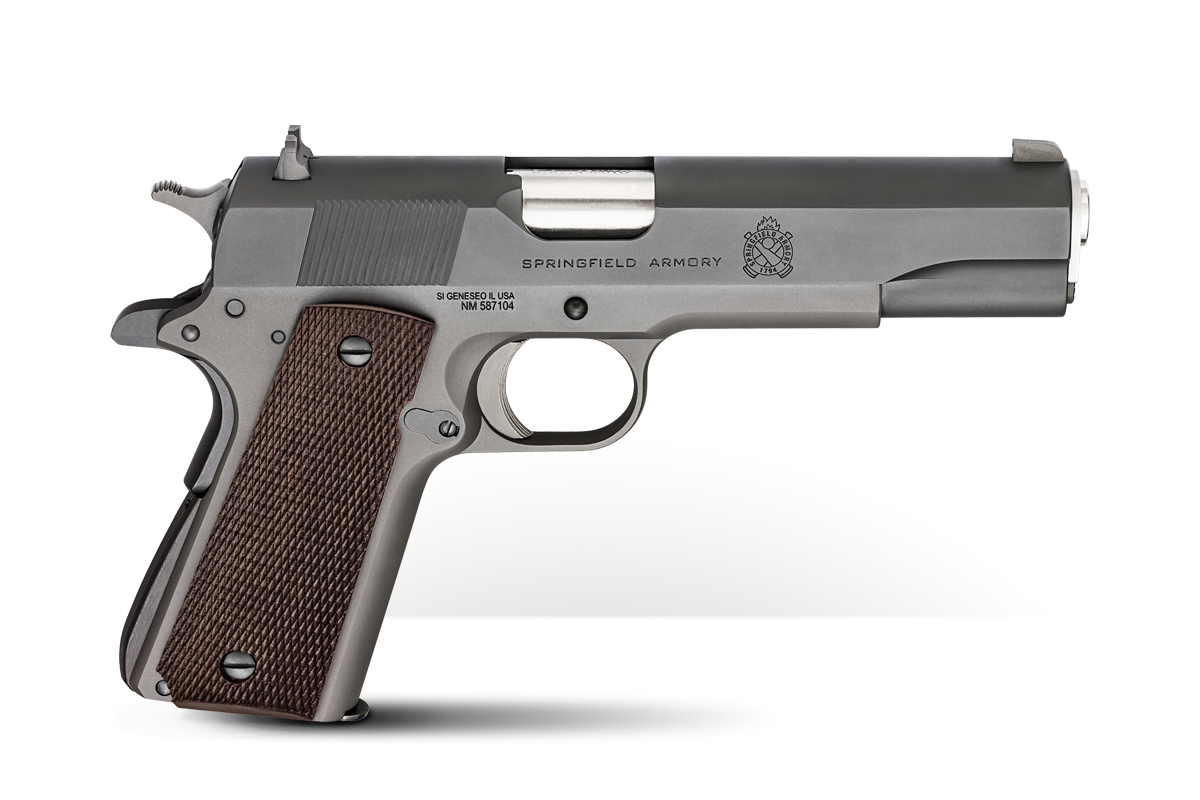While some military pistols have come and gone, ending up mostly as museum exhibits, the 1911 is still around. The 1911 is the real deal and continues to evolve with double-stack magazine versions and features like Picatinny rails for tactical light, as well as slides factory cut for optics. That doesn’t even include models with bull barrels, models sans the old-school bushing, or full-length guide rods for smooth operation, and extended beavertail grip safeties for those of us with hands the size of canned hams.

None of these enhanced 21st-century 1911s would have seen the light of day if it weren’t for the original mil-spec 1911. The 1911 went on to be America’s longest-serving sidearm, and the enthusiasm for the 1911-style platform pistols continues. In my opinion, the original mil-spec 1911 pistols have real mojo.
The Beginning
When Uncle Sam was testing pistols in the early 20th century, stopping power was high on the must-have list. The .45 ACP was the cartridge of choice, and a new pistol in that chambering was unstoppable during the trials.

It was kind of a no-brainer for the Army brass to adopt the new firearm as the Model 1911. The design has changed over the years, with it being re-designated the M1911A1 in the 1920’s. That 1911A1 served during the Second World War, the Korean War and the Vietnam War. Uncle Sam ended up procuring about 2.7 million 1911 mil-spec pistols over the years. There’s a reason the 1911 pistol was bought in bulk.
Think of the span of time this firearm has endured. Hard to believe 1911 first saw service with the calvary—yes the type with horses—in 1916 when John “Blackjack” Pershing chased after Mexican revolutionary Francesco “Pancho” Villa at the Texas border with Mexico. Not many pistols have the endurance and stamina to span the length of time the 1911 has.

G.I.’s nicknamed it “Old Slabsides” because of the plain flat sides of the slide, but there is powerful magic in it. Some call it Browning’s design genius, I call it mojo. Mil-spec 1911s are not the coolest looking 1911s, nor the most beautiful — although there is a beauty to its clarity of purpose. They were designed to take abuse and give it back. Designed as a combat pistol, it hangs tough with the latest striker-fired pistols because of its stellar features.
The Details
Let’s start with the grip angle. Eighteen degrees is the sweet spot. Other handguns insist a 22-degree grip angle is best, but point a 1911 and it fits your hand like it was made for you. I prefer the thin wood or plastic grips on a mil-spec 1911 because it feels thin in my hand and there is no girth to wrap my fingers around. It doesn’t feel chunky like it does with some double-stack magazine pistols.
The next feature to consider is the trigger. Ah, a 1911 trigger. On a mil-spec 1911, the trigger’s job is to do one thing — release the hammer. Even the worst 1911 trigger pull is better than some trigger pulls on some modern semi-automatic pistols. The single-action trigger pull on the 1911 is perhaps its most endearing feature. There is no other trigger I like more and can shoot better than a 1911 trigger. The mil-spec trigger is short, compared to the longer triggers in vogue today, and it allows me to press it back with minimal movement and no jerks so the bullet hits what I intend to hit.
Call me old school, but when I think 1911, I think .45 ACP. The caliber’s performance in combat and on the street is unimpeachable. Sure, it takes a bit to master the recoil, but that’s why you consistently train, right? I also think the single-stack magazine of seven to eight rounds is a darn good payload because I think of it this way: It doesn’t matter if I have 17 rounds in the tank, what matters is what I’m going to do with my first three rounds.

The last attribute I like about mil-spec 1911s is the muzzle bushing and ease of maintenance. While the fieldstrip process on a 1911 may seem like a Rubik’s Cube to some compared to the disassembly ease of modern guns, the steps help me to understand the “bones” of the 1911.
[Don’t miss Massad Ayoob’s review of the Springfield 1911 Mil-Spec.]
The honorable mention list is the ease in loading cartridges in the magazine. You don’t bust your thumb loading those single stacks. Safeties, too. In fact, the 1911 has multiple safeties to make it extremely secure.
Conclusion
Today, the term 1911 has become generic to mean any pistol that employs a 1911-style platform, meaning a semi-automatic pistol with a single-action trigger and a recoil-operated system. All the extended beavertail grip safeties, magwells, Picatinny rails, lowered and flared ejection ports, and a litany of other enhancements make a great modern 1911, but it all came from the mil-spec 1911. That why mil-spec 1911’s have mojo.
Editor’s Note: Please be sure to check out The Armory Life Forum, where you can comment about our daily articles, as well as just talk guns and gear. Click the “Go To Forum Thread” link below to jump in and discuss this article and much more!
Featured in this article
The post Mil-Spec Mojo appeared first on The Armory Life.
